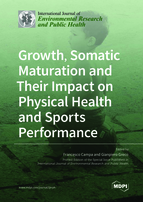Growth, Somatic Maturation and Their Impact on Physical Health and Sports Performance
A special issue of International Journal of Environmental Research and Public Health (ISSN 1660-4601). This special issue belongs to the section "Exercise and Health".
Deadline for manuscript submissions: closed (30 November 2021) | Viewed by 56803
Special Issue Editors
Interests: anthropometry; bioelectrical impedance analysis; body composition; nutritional factors; exercise testing; growth; sports performance; lifestyle
Special Issues, Collections and Topics in MDPI journals
Interests: physical activity; fitness; exercise physiology; health promotion; body composition; human performance; special education; nutrition; tactical populations; sport psychology; strength and conditioning; combat sport; data analysis; research methodology
Special Issues, Collections and Topics in MDPI journals
Special Issue Information
Dear Colleagues,
The evolution of a healthy and successful athlete is multifaceted in nature. Various factors including technical skills, physical performance, environmental circumstances, and social conditioning contribute to the development of this process. Over time, complex interactions and a nonlinear progression among these variables contribute to the improvement of physical health and of the elite level achievement in youth athletes.
An influencing factor of growth and physical performance is somatic maturation. The pubertal period is a critical time frame for skill acquisition and development of performance in youth people, in which suitable training strategies should be adopted to preserve the state of health while avoiding the risk of injury. Athletes with similar chronological age competing in the same category levels can, in fact, show a difference in maturity status, and therefore in size, function, and body structure. Physical and psychological differences related to maturity status and birthdate amongst athletes of the same selection year have been identified in a variety of sports and could be linked with dropout of youth practitioners and a reduction of the talent pool.
Contemporary researchers have contributed to the field of research on improving health and sports performance through the development of new measurement methods and training strategies in youth athletes. The aim of this special issue is to propose new training programs aimed at improving health status and physical performance in youth athletes, while highlighting the relationship with somatic maturation throughout longitudinal and cross-sectional studies. The aim of this research collection is to add information on:
- Effect of physical activity on sport performance and benefits on health status in youth people;
- Exercise programs for improving physical performance in youth athletes, taking into account their maturity status;
- Strategies to support developing talent and to prevent drop out in youth sport;
- New evidence for somatic maturation and physical fitness measurement techniques;
- Incidence of traumatic and overuse injuries during growth.
Investigators that have conducted studies on these topics are invited to submit manuscripts for consideration for this Special Issue in IJERPH.
Dr. Francesco Campa
Dr. Gianpiero Greco
Guest Editors
Manuscript Submission Information
Manuscripts should be submitted online at www.mdpi.com by registering and logging in to this website. Once you are registered, click here to go to the submission form. Manuscripts can be submitted until the deadline. All submissions that pass pre-check are peer-reviewed. Accepted papers will be published continuously in the journal (as soon as accepted) and will be listed together on the special issue website. Research articles, review articles as well as short communications are invited. For planned papers, a title and short abstract (about 100 words) can be sent to the Editorial Office for announcement on this website.
Submitted manuscripts should not have been published previously, nor be under consideration for publication elsewhere (except conference proceedings papers). All manuscripts are thoroughly refereed through a single-blind peer-review process. A guide for authors and other relevant information for submission of manuscripts is available on the Instructions for Authors page. International Journal of Environmental Research and Public Health is an international peer-reviewed open access monthly journal published by MDPI.
Please visit the Instructions for Authors page before submitting a manuscript. The Article Processing Charge (APC) for publication in this open access journal is 2500 CHF (Swiss Francs). Submitted papers should be well formatted and use good English. Authors may use MDPI's English editing service prior to publication or during author revisions.
Keywords
- Growth
- Body composition
- Exercise training
- Injury risk
- Physical health
- Somatic maturation
- Youth athletes
- Physical performance







